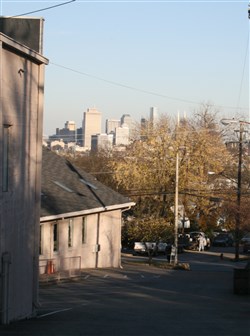VOL. 41 | NO. 47 | Friday, November 24, 2017
Hill (College or City?) with a view: Yours for a mere $30 million
If you are a developer with $30 million to spare for 2.69 acres of prime real estate overlooking downtown Nashville, the Rev. George T. Brooks has a deal for you.
“No one’s going to do that, though,” says the 70-year-old pastor of St. James Missionary Baptist Church on a 28th Avenue North hillside just up from Swett’s Restaurant, the landmark business where Southern cooking is devoured while the worries of the world – including the fate of this neighborhood – are bandied about among the regulars.
The Rev’s price tag for the St. James property is high enough that the church could afford to buy seven acres or so, perhaps out in Bordeaux, build another beautiful worship structure and 30 or 40 affordable houses surrounding it. The plan is to take some of the church community out to the edge of town so that parishioners, displaced by rapid-fire gentrification, can – along with their church – start over.
“We would want to start another community there,” says the pastor, who is watching as the $400,000 – give or take a quarter-million – townhouses and tall-skinny homes devour the part of the city he has served for 33 years.
He smiles and shakes his head, side-to-side. “It’s not going to happen,” he adds. “Developers are out there to make money, not to invest in the community.”
Two rental homes, a building with four apartments and two vacant lots are part of the package offered any high-rolling developer of the pastor’s dreams. It should be noted here that the church rents those properties on a pay-what-you-can plan. Rent for one apartment is $100 a month. Others pay $300 or $325, with houses renting for $600 monthly.
Of course, the most impressive structure on this hill is the 35,000-square-foot church, which has undergone plenty of renovation in the years since it first built on this hill in 1949.
The pastor says $30 million is “the starting point,” but it’s pretty certain the church would hold out for that amount. After all, not only is it great land for developers … it has the heart of Music City within eyeshot.
And, remember, legendary Swett’s is just down the hill, ready to fill the bellies of the affluent new residents of what most call North Nashville (although I’m told by local geographic purists and philosophizers that West Nashville actually begins just across 28th Avenue North from the restaurant).
Regardless, most of the newcomers will know this area as “City Heights,” the name given the gentrification-fueled development that begins a block or less from the St. James church.
Down at Swett’s, that new City Heights neighborhood moniker earns, to be kind, mixed reviews.
“This area already has a name: College Hill,” explains James Taylor, 62, who has spent his life in North and West Nashville and who – tapping on his stomach – admits too much of that time has been spent at Swett’s, where he dines at least once a day.
“They are changing it to City Heights,” he explains, referring to the developers whose new upscale housing begins a half-block from the restaurant.
“It was called College Hill because all the students from Fisk and TSU used to rent apartments here,” recalls the retiree from the automotive business. When I ask him if he is retired from the business of making cars or of selling them, he just smiles. “All of that.” And more, I’m sure.
I first caught up with James at what I’m told is “The Adult Day-Care Center,” a section of Swett’s where tables are filled up with older gentlemen who sort out the day’s woes and swap tales. They invite this age-appropriate, 66-year-old journalist to scoot up a chair.
The new moniker of City Heights is a lively part of the discussion. Other items on the agenda include politics – local and national – as well as people and places that have come and gone over the decades.
“I don’t have a problem with City Heights,” says beloved restaurateur David Swett, who sits at the head of the table – or cluster of tables if the turnout is good – during this two-plus-hour, all-male gathering over fried chicken, potatoes, greens and cornbread. The chicken seems the favorite of this geriatric gathering, though ribs and more also are available in the cafeteria line. I go with the chicken.
“I call it North Nashville,” says James, who at one point was a candidate for county sheriff. “I wish I’d won,” he adds, without regrets. At least he took a shot at it.
“After they put 300 new (condo) units here it will change the neighborhood,” says David, who praises the “beautiful” residential construction nearby his restaurant.
David says the change, for the most part, is good.
“I don’t have a dog in this fight,” adds David, who calls himself “the last of the Swetts,” mainly because he’s the last family member working at this Mt. Rushmore of Nashville’s meat-and-threes that for decades has been the heart of the neighborhood being redubbed “City Heights.”
“When people have the money, they have the right to use it,” he acknowledges, explaining why he doesn’t mind the developers and civic image brokers redubbing his neighborhood.
“This is the United States of America. Well, we got a dictator now, but it’s still the United States of America.”
David allows that he sees the change as something to embrace. For one thing, he hopes newcomers to City Heights will satisfy urges for Southern cooking at Swett’s, it’s open 357 days a year (there is a week or so around Christmas when it’s closed).
“This is a landmark people want,” he explains of his family restaurant. He notes that all the new construction going on around what I’ve always called “the Swett’s neighborhood” is good … for the most part.

View from the parking lot of St. James Missionary Baptist Church, 600 28th Ave N., which the congregation is offering to developers for $30 million. The area has become a hotbed for residential real estate development.
-- Tim Ghianni | The Ledger“We have a lot of vacant lots and old houses in this community,” he says of the neighborhood, which until the invaders began arriving was mostly a quiet community where professors from TSU and Fisk lived side-by-side with some of our city’s working-class heroes, and – of course – the occasional decaying, abandoned home and the urban thugs drawn to them.
Older houses are being sold to developers who demolish one-story homes to make way for four upscale homes on a single lot, a disturbing trend across Nashville.
“I’m 72 working on 83,” David says, as he nods out the plate-glass at the traffic passing by his establishment. He knows names can be very important.
“I fought it when they wanted to change the name of Clifton Avenue to Swett. I didn’t want them going on the news saying that ‘someone was shot over on Swett.’” He laughs, but he’s deadly serious.
That gunfire isn’t confined to any one area of the city, but in the blighted parts of North Nashville, including areas within a hundred yards or so of this restaurant and McKissack Park right behind it, there has been a history of violence. Guns, dope and careless kids breed death here as well as across the city … and, of course, even out in the suburbs.
That negative part of this neighborhood’s history is noted by James Bowen, 71, who arrives in time to catch the “second shift” of the Adult Day-Care gathering.
“All those changes. All the new people. They don’t know what they are getting into. They are going to have a rude awakening,” he adds, an acknowledgment of the pistol-packing punks who still roam these streets, mostly by night, and how they might welcome new neighbors.
Still, the head of the Swett family (and proprietor of this well-seasoned Day-Care) sees the change and the newcomers mostly as pluses, an opportunity to clean up the community.
“I don’t see it as a bad thing,” he says, with men nodding agreement, others shaking their heads.
Of course, it’s going to happen regardless of what these fellows either desire or despise.
Perhaps the last outpost of what used to be “old” Nashville is gentrifying, with high-priced condos going up to serve the booming growth of our “It City.” And new houses – of the tall-skinny variety or otherwise – are overtaking not only empty, overgrown lots but also are replacing, by bulldozer or other implements of destruction, family homes of many folks who have lived here generations.
They, of course, for the most part can’t afford the new housing, rent hikes or increases in property tax.
Adult Day-Care ringmaster David interjects that the fact folks are being forced from their homes by progress is “the unfortunate part.”
“The thing that gets me is: when did North Nashville stop being North Nashville?” pipes in Arnett Bodenhamer, 84. “The Planning Commission started it. There have been a lot of changes based on the growth of the city.”

The Rev. George T. Brooks
Before answering a cell-phone call, David points out folks should look to the positive. “It will improve our community. I still believe in America and the American Dream. I don’t talk about the way things used to be.
“Any time you put something new in … as we move forward, the city is going to change. This is the last area closest to downtown Nashville that hasn’t already been developed.”
Again, the topic shifts to what is going to happen to the old-time renters and to the students from nearby colleges who used to find affordable rental housing here.
“A lot of retirees live out here,” says James Taylor, who likes to joke that he is no relation to Sweet Baby James, the very-pale-skinned “Fire and Rain” singer: “I never married Carly (Simon) and I don’t have James Taylor’s money. And if I sang, you’d be running off.
“What are the retirees going to do? They either have to spend more money on taxes and rent or perhaps they’ll move away.”
As for the students. “Used to be you could get a nice two-bedroom townhouse here for $600 or $700 a month. Now I’ve been told the rents are $900 to $1,000 a month. Students can’t afford that.”
The future of the area around Swett’s remains uncertain. The only sure thing is that the cavalry of change has ridden in on demolition-and-construction gear, with reinforcements and cement trucks on the way. Blocks and yards all over the area have been cleared and are marked by signs saying something – a house, a store, an office, whatever – is “Coming Soon.”
Driving back into the neighborhood, I encounter Samantha Pruett, 35, who is standing on the porch of the 26th Avenue North house from which she sells candy and other treats.
“It will be nice to see some new houses,” she says after asking me if I’m a cop and becoming reassured – though remaining slightly suspicious – by my answer. “I feel bad for the people, though, as they (the forces of change) buy the property up.
“They been here,” and now they are being forced to leave. “That ain’t cool,” Samantha adds. “Those people have been here a long time. It ain’t right.”
Another neighbor, Stephen Phillips, 48, pretty much embraces the change, with slight reservation. “It’s getting a lot of the old, vacant lots cleaned up,” he says, as he sits on a porch overlooking 26th North. “There’s going to be a lot of change, some for the good, some for the bad. That’s life. Take the good with the bad, and move on.”
One thing “for the bad” – according to everyone I meet during my days of bothering people around here – is the traffic caused by all the newcomers and more carried here by the 28th/31st Connector that links this with other neighborhoods and also provides a surer pathway to get to our hospital campuses. It also makes West End and Wedgewood avenues easily accessible.
“After work in the evenings you can’t get up and down 28th Avenue,” says Stephen, a carpenter who also washes and repairs cars.

David Swett
A couple blocks away, Nathan Williams, 34, is parked outside Swett’s Market – a gas station and quick shop just across Clifton from the restaurant.
A flatbed trailer behind his pickup is filled with a dishwasher, dry-wall, other building materials and huge outdoors (and I hope hearty) tropical plants and trees that he’s hauling over to a construction site up on Buchanan Street, another area of swift change.
“I do landscaping, hauling and cleaning,’’ Nathan says, adding that the growth “Is good for me, yeah.”
The fact it’s bringing jobs and shining a new light on this community is one thing the guys in the Adult Day-Care agree is good. In their swirling conversations, they also praise Cassius Clay/Muhammad Ali and Wilma Rudolph and offer quite the opposite (though without profanity, for these are gentlemen) for Trump. The fact I knew Wilma and Ali reassures these fellows.
Up the hill, where I apologetically interrupt some of Pastor Brooks’ Tuesday Bible-study planning time, this decent man of the cloth acknowledges his St. James congregation backs his high-dollar dreams.
“Ninety-two percent are in favor of us selling it if we could get what we want: $30 million.”
He has shaken off those seeking this hill for considerably less. “Five million. Eight million,” he scoffs.
He’s not against the change, especially if he and his church can cash in – a prospect, you may recall, that he doubts will occur.
“It’s good. A lot of good-paying jobs are coming to Nashville,” says the pastor when remarking on the bustling “It City” (I’ll be glad when some other burg is tagged with that hyperbolic label.)
They better be good-paying jobs, he reckons, if folks move into the upscale housing sprouting around him.
The pastor does not see the change through rose-colored glasses. “People who are renting homes in the neighborhood now are going to be up the creek without a paddle.
“A lot of low-income people from around here are moving to Rutherford County, Robertson County, because of the inability now to find affordable housing in Nashville.”
The pastor, who draws between 275 and 300 to his Sunday double-header, adds that “If I was younger, I could throw a rock and hit” – in any direction – the new building that’s going on.
He knows taxes in the neighborhood are going to go up and poorer people are going to have to move, but there is one big plus.
“We’ll get better policing. We have people do drugs and have sex out here even during daylight,” he notes, waving out toward some of the more-remote parts of the church property.
“I see a lot of cars rocking on top of our hill. He offers a sort of exhausted and melancholy laughter when describing how he found one of his young female parishioners so engaged with a young man. She was embarrassed, he says.
He praises the police who have agreed to “write their reports and take their breaks right here on our property.”
He worries that the developers will somehow privatize, offer permit-only street parking for condo residents, making it tough for his congregation to come on Sunday mornings.
The fates of the old-timers and the upscale invasion aren’t all he’s worried about.
“The challenge for those purchasing these units really is going to be 20 to 25 years from now.
“People are buying these things very quickly. They are in their 20s and 30s.
“Americans are getting heavier and heavier. A lot of these young people, when they get into their 40s and 50s are going to have joint problems. And a lot of those are buying these tall houses. They are straight up.” He motions toward the ceiling.
That multi-story climb seems easy for young people. But it could prove impossible for the aging Americans who become physically unable to climb the stairs and enjoy their homes fully.
“Twenty years from now, unless they can find somebody to sell it to, these owners are going to have a white elephant. Going to be an awful lot of folks who wish they never bought these three and four-story houses,” he predicts.
At that point, the simple, one-story homes that quickly are being demolished for the needs of the invading gentry may well be missed.
“Many of them are going to have to hope a whole lot of folks living in a one-story house are going to die off.”